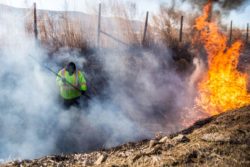Spring means ditch and fence burning time. Neighbors and framers use torches to ignite the matted grasses, and weeds that have accumulated in their ditches and along their fence lines. Some farmers burn grasses along watersheds and pastures.
Controlled or Prescribed Burns are a tool that many landowners use. The concern of many about this practice is how does it impact our environment? Does this contribute to Global Warming and Climate Change?
Local jurisdictions require fees, permits, or notifications before you flame up your ditches. Check your local rules. This also comes with some education and procedures for managing your burn.
PROS;
Weed Control
Insect Control
Allows for better irrigation and less lost water.
Burning replaces nutrients into the soil
Native Americans practiced burning for centuries to regenerate grazing grasses
Thick seeds germinate better after a burn.
Soil and land are revitalized
CONS
Burning makes soot filled smoke
Smog and air pollution are an issue
Trash, plastics, and other pollutants are burned and produce toxins
Carbon Monoxide becomes airborne
Habitat and other organisms are destroyed
As the smoke clears, we need to measure the outcomes. Burning may create some pollutants but eliminates the need for insecticides, herbicides, fertilizer, and other chemicals. This is certainly a healthy outcome. Water management for irrigation is improved. Currently Prescribed Burning is a legal and legitimate tool for wildlife, agriculture, forestry, and land managers to use.
Just another New Green part of the Deal!
Montana Grant
For more Montana Grant, find him smoldering at www.montanagrantfishing.com.